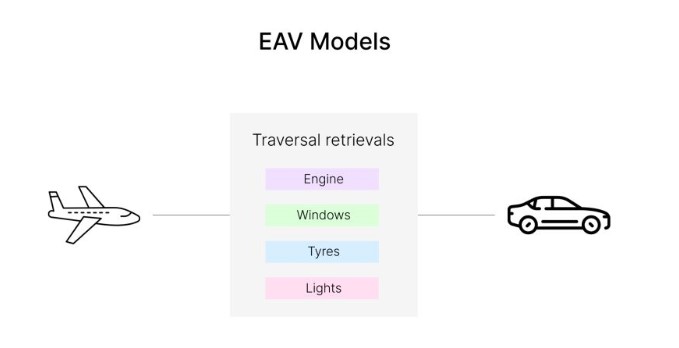🌐 EAV (Entity Attribute Value) Model Explained

EAV (Entity Attribute Value) models can have complex structures and traversal retrievals.
💡 Concepts are connected with each other in the form of substructures and hierarchies.
✈️ Example of an EAV Hierarchy
The hierarchical structure of an entity like "Plane" could be as follows:
Plane 👉🏻 Wings 👉🏻 Engine 👉🏻 Parts of Engine
- 🔸 Each entity in the structure has attributes of different types.
- 🔸 Each attribute has values assigned to them.
That’s why it’s called an Entity → Attribute → Value model.
🔍 What is Traversal Retrieval?
In traversal retrievals, the data of an entity is retrieved based on its connection to other entities.
For example, EAV models of both “Car” and “Plane” may share common components like:
- 🌴 Engine
- 🌴 Windows
- 🌴 Tyres
- 🌴 Lights
👉 These common entities will also have attributes and their respective values.
So, the data of an entity connected to an EAV model can be called via a mutual attribute from another EAV model.
🤔 How is it Related to SEO?
- 🧩 The EAV model can be read as JSON, making it easier for search engines to understand the data.
- 📄 Google has also mentioned this approach in its patents as an extensible data model.
-
🔗 Search engines can add semantic capabilities to their EAV models to:
- Interlink concepts
- Understand relationships
- Enhance semantic search accuracy
📝 EAV model samples can be derived from queries or documents.
🌐 EAV (Entity Attribute Value) Model – Explained with Examples
The EAV model is like a flexible database structure where data is stored in this format:
Entity → Attribute → Value
Instead of having fixed columns like in traditional databases, EAV allows you to dynamically add attributes to different entities.
✈️ Example: Plane Hierarchy (EAV Structure)
Let's break down the Plane as an Entity in a hierarchical structure:
Plane (Entity)
├── Wings (Sub-Entity)
│ ├── Attribute: Material → Value: Carbon Fiber
│ └── Attribute: Length → Value: 20 ft
├── Engine (Sub-Entity)
│ ├── Attribute: Type → Value: Turbojet
│ └── Attribute: Power Output → Value: 40,000 HP
└── Parts of Engine (Sub-Entity)
├── Attribute: Blade Type → Value: Titanium
└── Attribute: Cooling System → Value: Liquid Cooled
- ✅ Entity: Plane, Wings, Engine
- ✅ Attributes: Type, Material, Length, Power Output, Blade Type
- ✅ Values: Turbojet, Carbon Fiber, 20 ft, etc.
🚘 Another Example: Car Entity
Car (Entity)
├── Engine (Sub-Entity)
│ ├── Attribute: Type → Value: V8
│ └── Attribute: Power Output → Value: 500 HP
├── Tyres (Sub-Entity)
│ ├── Attribute: Type → Value: All-Terrain
│ └── Attribute: Diameter → Value: 18 inch
└── Lights (Sub-Entity)
├── Attribute: Type → Value: LED
└── Attribute: Brightness → Value: 1200 Lumens
Notice: Engine, Tyres, Lights are common components between Car and Plane.
🔍 Traversal Retrieval – Explained with Example
Imagine you want to retrieve all attributes and values related to "Engine" regardless of whether it's part of a Car or a Plane.
- ✔️ You don’t look directly at a table.
- ✔️ You follow the connections (relationships) between entities.
- ✔️ You can query: "Give me all attributes and values of the entity 'Engine' in all connected models."
So, you might get:
Engine (in Car): Type: V8, Power: 500 HP Engine (in Plane): Type: Turbojet, Power: 40,000 HP
This flexibility makes EAV extremely powerful for complex, interconnected datasets.
🤖 Why is EAV Important for SEO & Semantic Search?
Search engines like Google want to understand the relationships between concepts, not just keywords.
💡 Using EAV, content and data can be:
- 🔸 Represented in a semantic structure (JSON-LD, Schema.org)
- 🔸 Interlinked in meaningful ways
- 🔸 Easily read by search engines to enhance contextual understanding
🔗 Example for SEO:
{
"entity": "Car",
"attributes": {
"Engine Type": "V8",
"Tyre Type": "All-Terrain",
"Light Type": "LED"
}
}
This structured data helps Google:
- ✅ Understand what the content is really about
- ✅ Show better rich results
- ✅ Improve semantic search and voice queries
